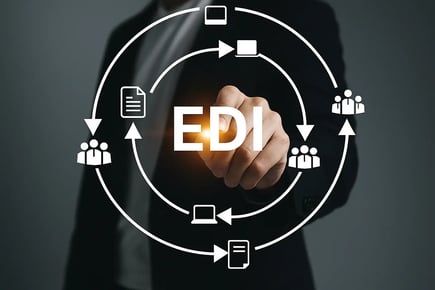On this page
Subscribe for updates
Keep up with OrderEase and access industry-leading order operation insights.
When purchase orders are stuck in inboxes or manually entered from spreadsheets, growth slows down. Each manual step adds delays, errors, and frustrated customers.
EDI ordering replaces this with automated, structured document flows directly into your ERP. It’s faster, more accurate, and scalable. But if you're considering EDI, it's probably because big box stores require it. The real question is: Is EDI integration worth the investment?
With EDI, companies experience faster processing, fewer errors, and better compliance. It can drive down operational costs and speed up your order-to-cash cycle, all while reducing the risk of costly mistakes.
However, the setup process can be costly and time-consuming, especially when using providers like SPS, which many retailers require. Should you stick to traditional methods, like email orders from smaller retailers, or take the plunge into EDI ordering to reach bigger stores and expand your business?
In this guide, we’ll break down how EDI works, its pros and cons, and how solutions like OrderEase can simplify the process, ensuring your business scales without the typical headaches.
The Pain of Traditional EDI Software
Many businesses rely on EDI software that’s disconnected from their ERP systems, causing manual data entry, errors, and inefficiencies. Without proper integration, EDI transactions must be manually processed, resulting in delays and mistakes. Data doesn’t flow smoothly between systems, requiring extra work to reconcile discrepancies and update multiple platforms.
For businesses handling high volumes of orders, the lack of integration can create significant pain points. Customer service teams end up manually re-entering data, checking multiple inboxes, and reconciling discrepancies across systems, leading to wasted time, frustration, and errors.
What is EDI Ordering?
Definition of EDI
EDI is the direct, machine-to-machine exchange of documents, replacing manual methods like email, fax, or phone orders that require re-keying
In North America, the most popular standards are ANSI X12, and in the rest of the world, EDIFACT. In such frameworks, most of the EDI order flows are based on a few documents:
- 850 – Purchase Order
- 855 – Order Acknowledgment
- 856 – Advance Ship Notice (ASN)
- 810 – Invoice
Businesses exchange these documents using secure methods like AS2, SFTP, or VANs (Value-Added Networks), which are often required by large retailers and distributors.
These have the effect of enabling order processing with quicker, higher accuracy, with fewer errors,
Where EDI Delivers Business Value
EDI isn’t just a technical standard; it delivers measurable business impact. Companies using EDI consistently see:
- Faster order capture with fewer manual touches
- Reduced errors in pricing, quantities, and packaging
- Compliance with retailer and distributor mandates
The advantages are indicated by GS1 and peer retailer surveys, including less manual labor, fewer entry charges, and shorter order-cash cycle times.
GS1, a global organization that sets standards for product identification and data exchange, helps businesses streamline their operations. By using identifiers like GTIN, GLN, and SSCC, companies improve supply chain visibility, enhance accuracy, and reduce errors across multiple systems and partners.
Although EDI is precise and fast, many companies still rely on email orders and spreadsheets due to legacy processes, a lack of integration, or resistance to adopting new technologies.
OrderEase brings all your disparate workflows into one streamlined process, ensuring a smooth integration with your ERP, WMS, or eCommerce systems. Depending on partner requirements, it supports connections via AS2, SFTP, VANs, or APIs. This means your documents flow directly into your operations, eliminating the need for manual data entry and reducing inefficiencies.
How EDI Differs from Traditional Ordering

Traditional ordering is people moving information between systems, reading emails, re-keying PDFs/CSVs, making calls, and filing attachments. EDI replaces those steps with system-to-system exchanges in pre-agreed formats, backed by confirmations and audit trails. The result: fewer touches, shorter cycle times, and consistent data.
Where Traditional Methods Fall Short
- Manual re-entry (PDFs/CSVs): Works at low volume, but doesn’t scale. It invites SKU, unit-of-measure, and price mismatches and depends on tribal knowledge.
- Phone & fax: Slow, hard to audit, and reliant on handwritten notes. Timestamps and ownership get lost, creating reconciliation work later.
- “Electronic” POs without EDI: Emailed spreadsheets or portal exports still need humans to ingest and validate. They lack standard envelopes, control numbers, and acknowledgments.
What EDI Adds
- Structure & validation: Orders arrive in standard formats. A 997 confirms receipt, and an 855 confirms whether the order is accepted or changed.
- End-to-end signals: Ship details flow via the 856 ASN; billing via the 810 invoice—creating a traceable chain instead of digging through email chains.
EDI delivers the structure and confirmations that traditional methods lack. But suppliers don’t live in an “EDI-only” world; orders also arrive by email, reps, and marketplaces. That’s where OrderEase goes further, unifying EDI and non-EDI orders into one queue.
OrderEase: The Complete Solution for EDI Ordering
When it comes to handling large volumes of orders, businesses need more than just a basic EDI system. OrderEase offers a comprehensive solution that not only automates the order process but also integrates seamlessly with your existing systems.
Whether you're managing inventory, shipments, or customer data, OrderEase simplifies and streamlines the entire workflow. Here's how:
- End-to-end automation: Manages the entire order lifecycle from processing to fulfillment, reducing manual intervention.
- Seamless integration: Connects effortlessly with your ERP, WMS, and eCommerce platforms for a unified workflow.
- Flexible connectivity: Works with various data transport methods like AS2, SFTP, VANs, and APIs to fit partner needs.
- Increased operational efficiency: Streamlines order processing, cutting down time spent on manual validation and data entry.
- Supports scalability: As your business grows, OrderEase adapts without requiring additional resources, ensuring smooth expansion.
Comparing EDI Ordering with Traditional Methods
| Factor | Traditional Methods | EDI Ordering with OrderEase |
|---|---|---|
| Speed | Manual steps slow cycles | OrderEase sends partner EDI documents automatically. |
| Accuracy | Prone to re-key errors | OrderEase automatically sends order confirmations and routes issues quickly to the right person. |
| Visibility | Status buried in emails | EDI messages (order confirmations, shipping updates) help you track orders from start to finish. |
| Scalability | Headcount scales with volume | OrderEase handles all order types in one place so processes can grow without additional staff. |
| Compliance | Varies by team | EDI compliance standardizes documents and makes order data auditable and consistent across teams. |
| Methods | Phone, fax, email | AS2, SFTP, or VAN (partner connection required) |
Cost Analysis
GS1 research shows that EDI reduces administrative costs and paper handling. In retail, it improves on-shelf availability and reduces replenishment delays. In contrast, traditional methods often bury costs in overtime, rework, and errors that take longer to fix.
Time Savings
With EDI, documents move in minutes, not hours. The order process confirms receipt quickly, and the acknowledgement shows if there are any changes. Traditional methods depend on business hours, manual follow-up, and constant back-and-forth, slowing things down and risking mistakes.
Scalability and Flexibility
A single EDI system can handle multiple partners, making it easy to scale. Traditional methods require more training for customer service teams, more inboxes to check, and more time spent managing each order manually. For big-box stores, AS2 is the standard. For smaller partners, SFTP or VANs can bridge the gap.
Case Studies: Success Stories of EDI Implementation
Real-world examples show how EDI order processing cuts errors, saves time, and scales without extra headcount. While these cases come from enterprise retailers and manufacturers, the same principles apply to mid-market wholesalers, and platforms like OrderEase bring those benefits within reach.
B2B EDI Success in Retail
Macy’s — Reverse ASN (RTV ASN) with EDI
Macy’s digitized returns using a Reverse ASN (RTV ASN), also known as a Return to Vendor Advance Shipping Notice, cutting returns processing time from several hours to about one hour per shipment, enabling 4× faster throughput. Over 25 years, Macy’s scaled EDI to cover POs, ASNs, and invoices, doubling in size without adding headcount.
Why this matters for EDI order processing
RTV ASN proves EDI is not just about sending POs; it also streamlines exceptions and returns. Clear acks and standardized data shrink dispute cycles.
With OrderEase, mid-sized suppliers gain the same ability to validate, acknowledge, and resolve exceptions before they become costly chargebacks.
B2B EDI in Food Distribution & Manufacturing
Dot Foods — EDI ASN halves receiving time
U.S. distributor Dot Foods measured pallet receiving time at ~40 seconds without an ASN vs ~20 seconds with EDI ASN. Across 13 distribution centers, that saved ~20 labor-hours per DC per week.
Standardized data moves faster through receiving. OrderEase applies the same principle for wholesalers by feeding clean, validated orders into ERP/WMS systems, reducing cycle times without adding staff.
Land O’Lakes — Accuracy up, labor down with EDI + GS1 identifiers
By using EDI ASNs with GS1 identifiers (GTIN/SSCC), Land O’Lakes cut labor by ~25%, lowered EDI errors to ~1%, and achieved ~99% order accuracy.
Why do these matter for EDI ordering system decisions
Structured data prevents mismatches and disputes. OrderEase brings this discipline to wholesalers by enforcing partner rules at the edge and ensuring consistent pricing, pack, and unit data before orders hit the ERP.
Which Ordering Method is Right for You?
Factors to Consider
- Volume and partner mix. High order volume and big-box customers point to EDI ordering.
- Error costs and chargebacks. If disputes and adjustments are rising, EDI order management pays back quickly.
- System landscape. If your ERP and WMS support mappings, an EDI ordering system can post cleanly.
- Transport requirements. If partners mandate AS2, build that into your plan. For wide partner networks, consider VAN or mixed transport.
- Team skills and time. If customer service representatives are buried in electronic purchase orders, move toward automation.
Final Thoughts
Traditional methods will not vanish overnight. Some buyers will still send electronic purchase orders by email. The goal is to reduce manual entry, standardize exchanges, and create clean audit trails. EDI ordering delivers those outcomes. Businesses that invest in EDI order processing and strong EDI order management enjoy fewer surprises and better partner relationships.
If your team is buried in electronic purchase orders and reconciling errors, OrderEase gives you a practical on-ramp: start with email automation, add priority partners on EDI, and expand quarter by quarter, without hiring a small army.
See it live. Book a 20-minute OrderEase demo and watch an emailed PO become a clean, acknowledged EDI order that posts to your ERP.
FAQs
1) What is “EDI ordering” / EDI order processing?
It’s the automated exchange of standardized X12 documents between systems—most retail flows use 850 (PO) → 855 (PO Ack) → 856 (ASN) → 810 (Invoice). This removes manual re-keying and speeds order-to-cash.
2) Which EDI documents are typically required by big U.S. retailers?
Target typically requires 810, 850, 852, 856, 860, 870, and 997 transaction sets. AAFES often requires 810, 850, 856, 860, GS1-128 labeling, and acknowledgments such as 824 and 997
3) What does an EDI 997 functional acknowledgment actually confirm?
A 997 is a digital receipt; it confirms a document was received and structurally valid; it doesn’t mean the order was business-accepted or processed by downstream apps.
4) AS2 vs. VAN: Which transport should we use?
AS2 is a direct, secure internet protocol favored by many large retailers; VANs simplify connectivity when you have lots of partners and limited EDI staff. Choice depends on partner mandates, volume, and in-house expertise.
5) How long does EDI implementation take?
Ranges vary by scope and partner responsiveness. Typical guidance shows ~4–6 weeks for a new setup, faster for adding a single partner, and multi-week programs for major retailers.
Integrate Your ERP
Ready to automate order data directly into your ERP? Discover integrations offered by OrderEase.
-4.png?width=1600&height=800&name=Blog%20Imagery%20(3)-4.png)

